Topics
Category
Era
West Side Flats, St. Paul
From the 1850s to the 1960s, St. Paul’s West Side Flats was a poor, immigrant neighborhood—frequently flooded but home to a diverse group of Irish, Jewish, and Mexican workers and their families. In the early 1960s all residents were moved out to make way for an industrial park.
A twenty-first century visitor to St. Paul’s Riverview Industrial Park would be surprised to learn that this area was once a residential enclave. This was the West Side Flats, and for about a hundred years, from the 1850s to the 1960s, life bloomed there. A unique neighborhood in Minnesota and the wider U.S., the Flats were dense, low-income, polyglot, striving, unpaved, and unpainted.
The Flats occupy the lowlands immediately south of downtown St. Paul and across the river. Where the land rises, or turns into a bluff, the Flats end and the rest of the West Side extends up and south to Annapolis Street, the border with West St. Paul. The Lafayette and High Bridges mark the east and west extensions.
The first non-Native residents of the Flats were French Canadians and Yankees. Then came Germans, more speakers of French, and refugees from multiple potato famines in Ireland, some of whom came to the Flats rather than to Connemara Patch across the river. The first bridge connecting the Flats with downtown St. Paul was completed in 1859. St. Paul annexed the West Side (then part of Dakota County) in 1874 and built a new bridge to replace the first where the Wabasha Bridge crosses today. The Robert Street and railroad bridges went up in 1886. From then on, the West Side was fully connected to the rest of the city.
Events in Russia affected the Flats as profoundly as the bridges. Just as famines in Ireland had done, pogroms and anti-Jewish laws in Russia set off mass emigration to the United States in the 1880s. The first Russian Jews reached St. Paul in winter 1882. About twenty of them made their way to the Flats later that year, and over the next few decades, hundreds more followed. By 1915 over 70 percent of the Flats’ residents were Jewish.
The Flats can be thought of as a village within the city. Made distinct by geography (river to the north, bluffs to the south) and language (Irish, Russian, Polish, Yiddish, Lithuanian), the Flats developed an internal economy based partly on family entrepreneurship. From a population that probably never exceeded two thousand, scores of businesses arose: junk dealers, egg candlers, tailors, cobblers, and butchers. A 1910 count found over a hundred such enterprises on the Flats.
Other men worked as laborers, and the West Side usually offered plenty of work. On the Flats themselves were American Hoist and Derrick, Minnesota Macaroni, Gedney Pickles, and the Waterous Company, maker of firefighting equipment. A little south, against the bluffs, stood Yoerg Brewery, Twin City Brick, and Villaume Box and Lumber. Farther south still were the South St. Paul stockyards.
Almost all the housing in the Flats was modest at best. There was no point in building a nice house; the Mississippi flooded nearly every spring, and on the lowland there was no escape. As early as 1917 a St. Paul housing survey found that almost half the houses in the Flats had no sewer connection. A third had no bathing facilities. The one public school, Lafayette Elementary, was poorly built and overcrowded. The city dump was nearby, and there were no parks—just one playground. In all, it was “the worst kind of slum.”
People lived there anyway. They built lives, livelihoods, and institutions. Irish Catholics worshipped at St. Michael's Church, which was built in 1866 and moved to a new location within the neighborhood in 1882. Two synagogues opened in 1889, and more followed, as did a cheder (a Jewish religious school). Neighborhood House, founded in 1900, was at first a Jewish settlement house but later opened to all.
In the twentieth century non-Jews arrived in appreciable numbers, especially Christian Syrians and Mexican Americans. Their church, Our Lady of Guadalupe, opened in the heart of the Flats in 1931. By then, Jews made up only about a third of the population of the Flats.
The Depression ensured that housing on the Flats, most of it built in the nineteenth century, would get worse. A devastating 1952 flood proved that frame houses built on a floodplain were vulnerable. In 1956 the city’s Port Authority announced the creation of Riverview Industrial Park—a project that needed every acre of the Flats. The city began buying houses in 1961 and tearing them down in 1962. By the end of 1963 the last residents of the Flats had left.
Bibliography
Holmquist, June Drenning, ed. They Chose Minnesota: A Survey of the State’s Ethnic Groups. St. Paul: Minnesota Historical Society Press, 1981.
Kunz, Virginia Brainerd, ed. Discover St. Paul: A Short History of Seven St. Paul Neighborhoods. St. Paul: Ramsey County Historical Society, 1979.
Moran, Gerard. The James Hack Tuke Emigration Schemes from Connemara, 1882–1884. Galway County Heritage Office.
https://heritage.galwaycommunityheritage.org/content/topics/galway-emigration-and-diaspora-connections/tuke-emigration-scheme/the-james-hack-tuke-emigration-schemes-from-connemara-1882-4
Pierce, Lorraine E. “The Jews of St. Paul’s Lower West Side.” American Jewish Archives 28, no. 2 (November 1976): 149.
——— . "St. Paul’s Lower West Side." Master’s Thesis University of Minnesota, Minneapolis, 1971.
Rosenblum, Gene H. The Lost Jewish Community of the West Side Flats 1882–1962. Chicago: Arcadia Publishing Co., 2002.
Related Resources
Goldberg, Emily. Lost Twin Cities III. [St. Paul, MN]: Twin Cities Public Television, 2012.
https://video.tpt.org/video/tpt-documentaries-lost-twin-cities-iii/
Ryder, Sara Bashefkin. Of Thee I Write: I Am a Product of the St. Paul West Side Flats. New Ulm, MN: Master Graphics of Minnesota, 1989.
Related Images
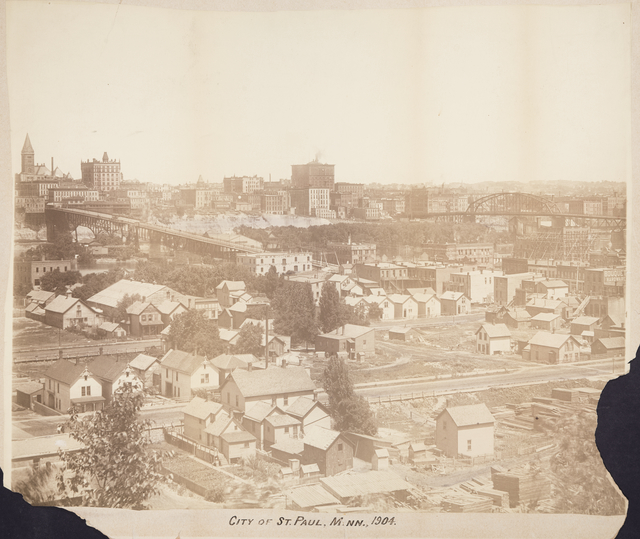
West Side Flats and Wabasha Bridge
Public domain
Holding Location
Articles
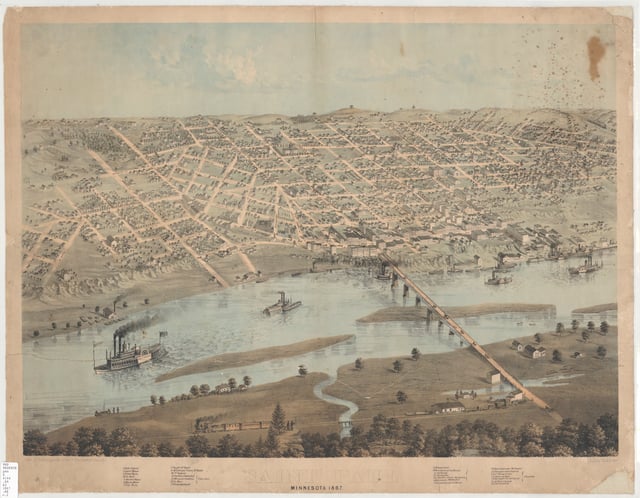
Downtown St. Paul and West Side Flats
Public domain
Holding Location
Articles
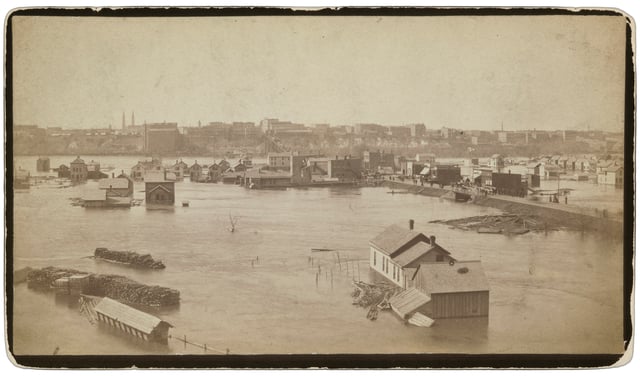
Looking north across the Flats during high water
Public domain
Holding Location
Articles
More Information
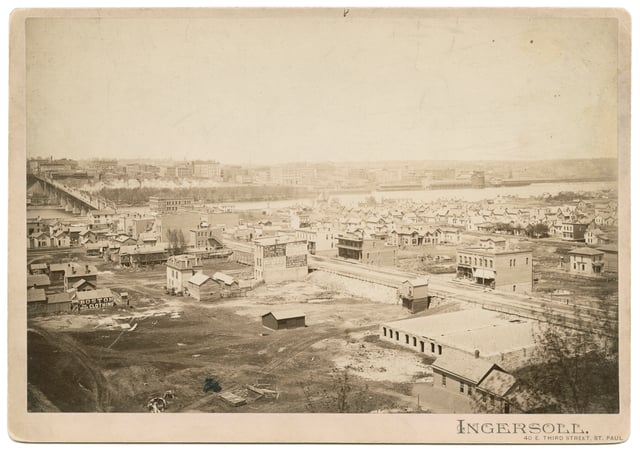
Lower West Side and Wabasha Bridge
Public domain
Holding Location
Articles
More Information
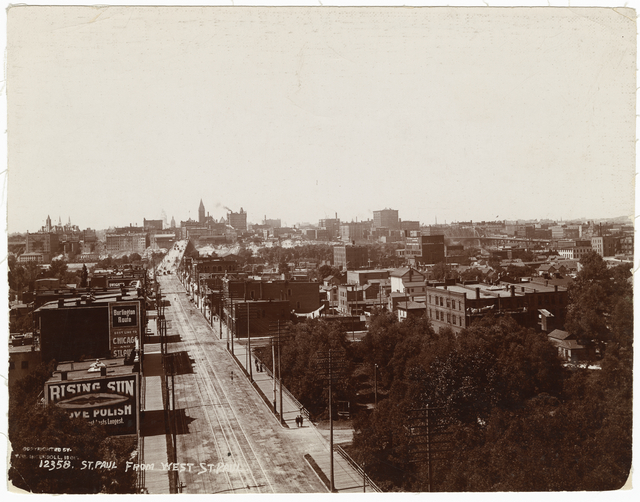
Looking north along Wabasha, the Flats
Public domain
Holding Location
Articles
More Information
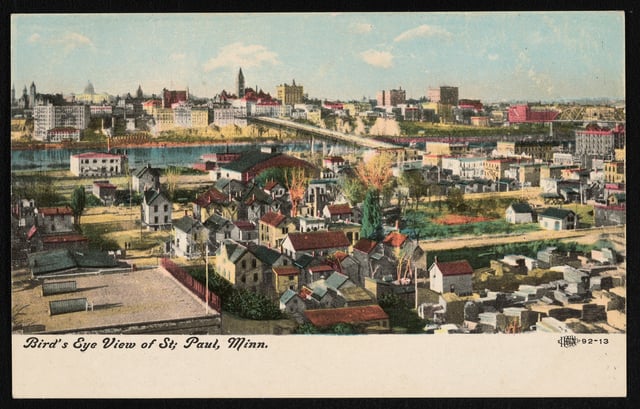
Postcard view of the Flats
Public domain
Holding Location
Articles
More Information

1916 plat map of the Flats, except the northeast portion
1916 plat map of the Flats, except the northeast portion. The main north-south streets were, left to right, Wabasha, Robert, and State. Plat Book of Saint Paul Minn. and Suburbs. Philadelphia: G.M. Hopkins & Co., 1916.
Public domain
Holding Location
Articles
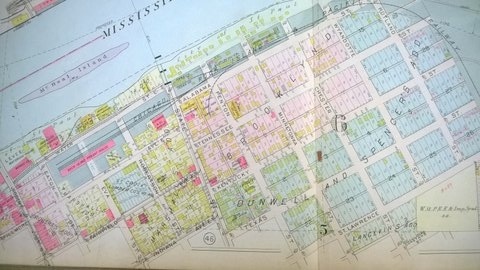
1916 plat map of that portion of the Flats not included in the previous map
1916 plat map of that portion of the Flats not included in the previous map. Historian Lorraine Esterly Pierce calls the area east of the Robert Street Bridge the Lower East Side. Plat Book of Saint Paul Minn. and Suburbs. Philadelphia: G.M. Hopkins & Co., 1916.
Public domain
Holding Location
Articles
Minnesota Macaroni factory, 114 West Fairfield
Minnesota Macaroni factory, 114 West Fairfield c.1917. Image from Aronovici, Carol. Housing Conditions in the City of Saint Paul. St. Paul: Amherst H. Wilder Charity, 1917, 46.
Public domain
Holding Location
Articles
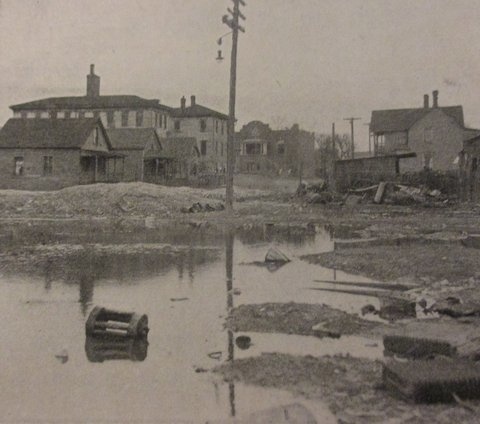
Lafayette School
Lafayette School, 1917. Image from Aronovici, Carol. Housing Conditions in the City of Saint Paul. St. Paul: Amherst H. Wilder Charity, 1917, 80
Public domain
Holding Location
Articles
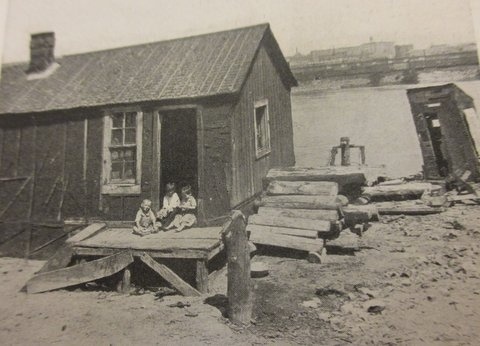
Shack and outhouse, river’s edge, West Side Flats
Shack and outhouse, river’s edge, 1917. Image from Aronovici, Carol. Housing Conditions in the City of Saint Paul. St. Paul: Amherst H. Wilder Charity, 1917, 24.
Public domain
Holding Location
Articles
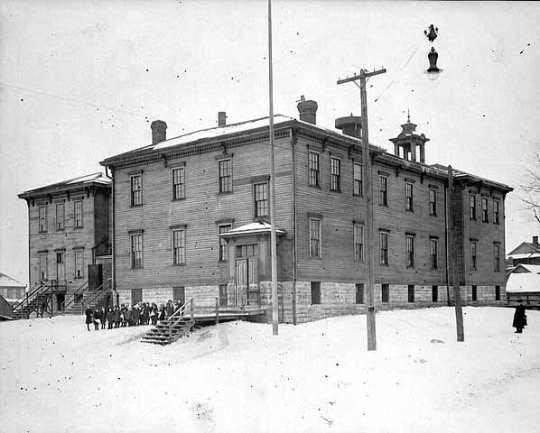
Lafayette School, corner of Kentucky and Fento
Public domain
Holding Location
Articles
More Information
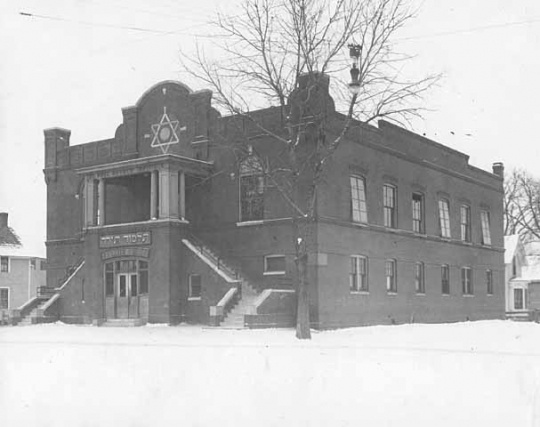
St. Paul Hebrew Institute, Kentucky Street
Public domain
Holding Location
Articles
More Information
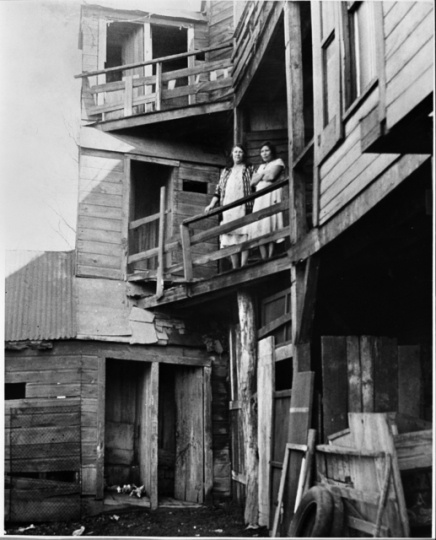
Three-story outhouse on State Street
Holding Location
Articles
More Information
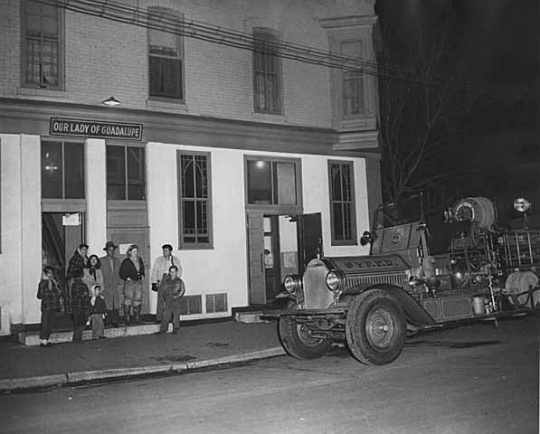
Our Lady of Guadalupe Church, 186 East Fairfield
Holding Location
Articles
More Information
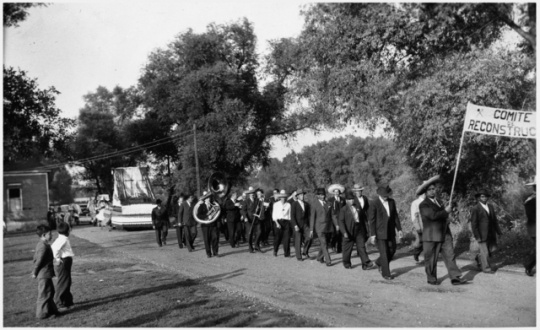
Cinco de Mayo parade, West side
Holding Location
Articles
More Information
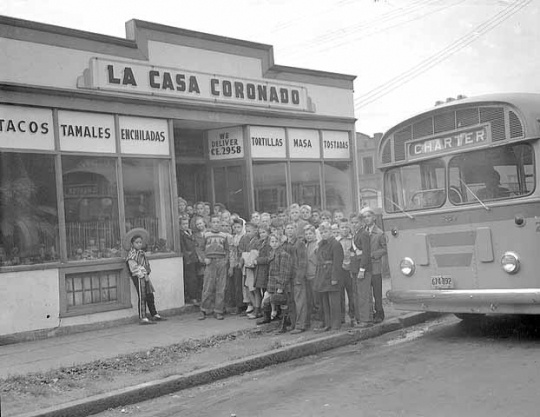
Students at Casa Coronado Restaurant, 154 E. Fairfield
Holding Location
Articles
More Information
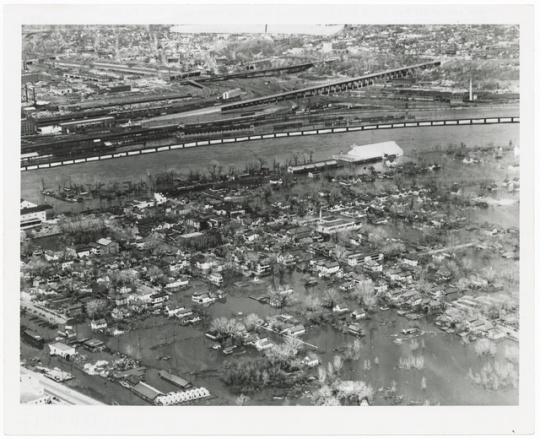
Aerial view of West Side during flood
Holding Location
Articles
More Information
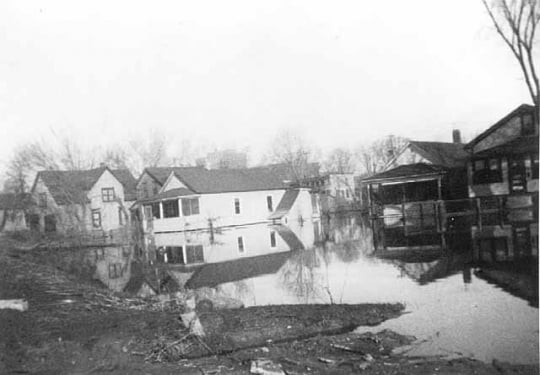
Tennessee Street during flood
Holding Location
Articles
More Information
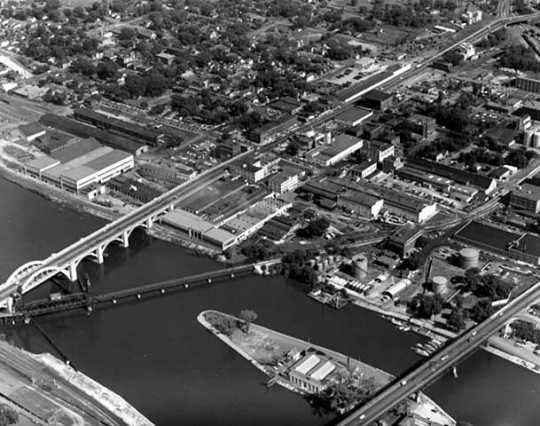
Aerial view of the Flats
Holding Location
Articles
More Information
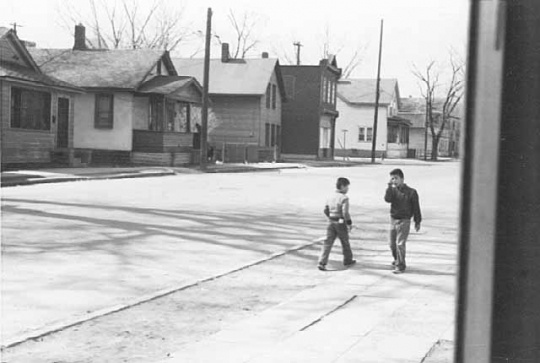
State Street, West Side Flats
Holding Location
Articles
More Information

Amhoist Complex and Robert Street Bridge
Holding Location
Articles
More Information
Related Articles
Turning Point
In 1952 St. Paul’s worst flood on record covers the Flats and persuades the local government that no housing should be permitted in the floodplain.
Chronology
1851
1866
1874
1882
1886
1889
1915
1917
1930
1931
1938
1952
1956
1961
1962
1964
Bibliography
Holmquist, June Drenning, ed. They Chose Minnesota: A Survey of the State’s Ethnic Groups. St. Paul: Minnesota Historical Society Press, 1981.
Kunz, Virginia Brainerd, ed. Discover St. Paul: A Short History of Seven St. Paul Neighborhoods. St. Paul: Ramsey County Historical Society, 1979.
Moran, Gerard. The James Hack Tuke Emigration Schemes from Connemara, 1882–1884. Galway County Heritage Office.
https://heritage.galwaycommunityheritage.org/content/topics/galway-emigration-and-diaspora-connections/tuke-emigration-scheme/the-james-hack-tuke-emigration-schemes-from-connemara-1882-4
Pierce, Lorraine E. “The Jews of St. Paul’s Lower West Side.” American Jewish Archives 28, no. 2 (November 1976): 149.
——— . "St. Paul’s Lower West Side." Master’s Thesis University of Minnesota, Minneapolis, 1971.
Rosenblum, Gene H. The Lost Jewish Community of the West Side Flats 1882–1962. Chicago: Arcadia Publishing Co., 2002.
Related Resources
Goldberg, Emily. Lost Twin Cities III. [St. Paul, MN]: Twin Cities Public Television, 2012.
https://video.tpt.org/video/tpt-documentaries-lost-twin-cities-iii/
Ryder, Sara Bashefkin. Of Thee I Write: I Am a Product of the St. Paul West Side Flats. New Ulm, MN: Master Graphics of Minnesota, 1989.






















